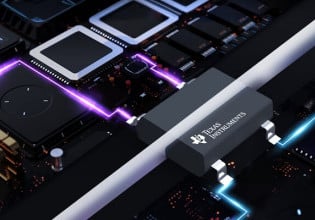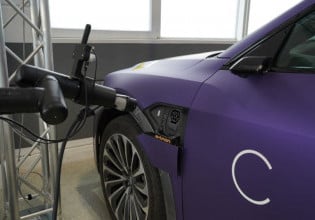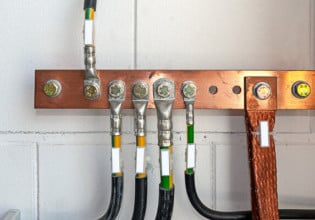National Electrical Code Basics: Overcurrent Protection Part 5
Learn about the protection of grounded conductors and the requirements above 1 000 V, and test yourself on overcurrent protection knowledge.
To catch up on Lorenzo Mari's series on Overcurrent Protection, please visit:
- National Electrical Code Basics: Overcurrent Protection Part 1
- National Electrical Code Basics: Overcurrent Protection Part 2
- National Electrical Code Basics: Overcurrent Protection Part 3
- National Electrical Code Basics: Overcurrent Protection Part 4
The ungrounded and grounded conductors follow different overcurrent protection rules. Fuses and circuit breakers over 1 000 V differ from lower voltage protection devices, so there are additional requirements for the protection of medium voltage circuits.
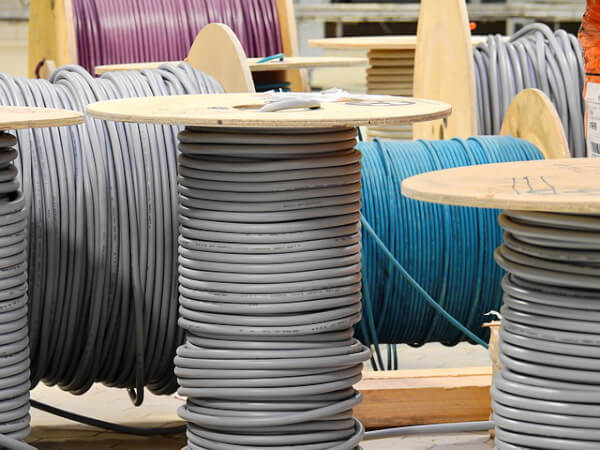
Image used courtesy of Pixabay
Section 240.22. Protecting the Grounded Conductor
• This section prohibits placing an overcurrent protective device on an intentionally grounded conductor except in the following cases:
○ When the overcurrent protection device opens all the circuit conductors, including the grounded conductor – the OCPD is designed so that no pole can operate independently.
○ Where required by 430.36 or 430.37 for motor overload protection.
Section 240.24. Location of Circuit Breakers and Fuses in or on Premises
• Overcurrent devices shall be readily accessible, except for busways (368.17(C)), supplementary overcurrent protection (240.10), overcurrent devices per 225.40 and 230.92, and overcurrent devices located adjacent to the equipment they feed if accessible by portable means – e.g., a ladder.
• In its highest position, the center of the switch operating handle shall not be more than 2 m above the floor or working platform.
• Except for multi-occupancy buildings and guest rooms in hotels and motels under continuous management supervision, overcurrent devices must be readily accessible to occupants.
• Overcurrent devices shall not be located:
○ Where subject to physical damage.
○ Close to easily flammable materials.
○ In bathrooms located in dwelling units or guest rooms of hotels and motels.
○ Over the steps of the stairs.
Section 240.30. Enclosures
• Overcurrent devices shall be protected from physical damage by one of the following methods:
○ Installation in enclosures, cabinets, cutout boxes, or equipment assemblies.
○ Mounting on open switchboards, panelboards, or control boards:
▪︎ In rooms or enclosures.
▪︎ Free of moisture.
▪︎ Far from flammable material.
▪︎ Accessible only to qualified personnel.
• A circuit breaker operating handle shall be permitted to be accessible without opening a door or cover.
Section 240.33. Vertical Position
Overcurrent device enclosures must be mounted vertically unless it proves impractical.
Section 240.101. Additional Requirements for Feeders Over 1 000 V
• The continuous ampere rating of a fuse shall not exceed three times the ampacity of the conductors.
• The long-time trip element setting of a breaker or the minimum trip setting of an electronically actuated fuse shall not exceed six times the ampacity of the conductor.
• Fire pump conductors shall be permitted to be protected per 695.4(B)(2).
• Conductors tapped to a feeder shall be permitted to be protected by the feeder overcurrent protection device if it also protects the tap conductor
Example 1. Compute the maximum fuse size allowed to protect a 4.16 kV feeder with conductors rated 140 A.
140 A x 3 = 420 A
420 A > 400 A
Use 400 A fuses
Example 2. Compute the maximum circuit breaker size allowed to protect a 4.16 kV feeder with conductors rated 97 A.
97 x 6 = 582
582 > 500
Use a 500 A circuit breaker
Questions and Answers About Overcurrent Protection
Question 1. Which one is an overcurrent protection requirement for grounded conductors?
A) Each conductor intentionally grounded must have an overcurrent device connected in parallel or series.
B) No overcurrent device is permitted in series with any conductor intentionally grounded.
C) A series overcurrent device must be provided for each conductor intentionally grounded.
Answer: B, 240.22.
Question 2. Which one is an exception to the rule in Section 240.22?
A) When the overcurrent protection device opens all circuit conductors simultaneously, including the grounded conductor, and no pole can operate independently.
B) When used on floating systems.
C) Where each pole can be driven independently.
D) None of the above.
Answer: A, 240.22(1).
Question 3. When in its highest position above the floor or working platform, the grip of the operating handle of the switch or circuit breaker will not exceed a height of:
A) 2 m.
B) 2.5 m.
C) 1.9 m.
D) 2.1 m.
Answer: A, 240.24(A).
Question 4. Overcurrent protective devices must be:
A) Accessible.
B) Readily accessible.
C) Accessible by several means.
Answer: B, 240.24(A).
Question 5. Overcurrent protection devices shall not be located:
A) Exposed to physical damage.
B) Exposed to the rain.
C) Exposed to flammable material.
Answer: A, 240.24(C).
Question 6. What precautions must be taken when placing the overcurrent protection device enclosure in a damp or wet location?
Answer: The enclosure will be weatherproof. It must be identified for the type of location and shall be mounted with a minimum of 6 mm airspace between the enclosure and the wall or other supporting surfaces, 240.32 and 312.2.
Question 7. What is the highest standard plug fuse rating requiring a hexagonal configuration?
A) 6 A.
B) 601 A.
C) 15 A.
D) 20 A.
Answer: C, 240.50(C).
Question 8. What is the maximum voltage permitted for plug fuses?
Answer: 125 V between conductors, 240.50(A).
Question 9. To which side of the circuit shall the screw shell of a plug-type fuseholder be connected?
A) To the line side.
B) To the load side.
C) Anyone.
Answer: B, 240.50(E).
Question 10. The fuse in the figure is a:
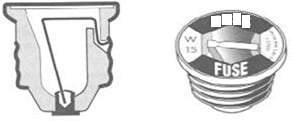
A) Edison-base plug fuse.
B) Type S plug fuse.
C) Edison-base cartridge fuse.
D) Renewable plug fuse.
Answer: A, 240.51.
Question 11. New Edison-base plug fuses shall be used for?
Answer: Only for replacement in existing installations where there is no evidence of overfusing or tampering, 240.51(B).
Question 12. Which of the following is a non-standard rating for a plug fuse?
A) 25 A.
B) 30 A.
C) 20 A.
D) 35 A.
Answer: D, 240.51(A).
Question 13. The highest current rating of an Edison-base plug fuse is:
A) 30 A.
B) 70 A.
C) 3 A.
D) 10 A.
Answer: A, 240.51(A).
Question 14. Which are two types of fuses?
A) Plug and cartridge.
B) Current-limiting and long-time delay.
C) GFPE and AFCI.
Answer: A, 240 (Parts V and VI).
Question 15. Which of the following is not required to be marked on a cartridge fuse?
A) Ampere Rating.
B) Expiration date.
C) Voltage Rating.
D) Name or trademark of the manufacturer.
Answer: B, 240.60(C).
Question 16. Circuit breakers can be operated electrically or pneumatically if they can also be operated:
A) By electronic means.
B) Easily.
C) Remotely.
D) Manually.
Answer: D, 240.80.
Question 17. Circuit breakers used as switches in high-intensity discharge lighting must be listed and marked:
A) No need for listing or marking.
B) HID.
C) Inrush current.
D) SWD.
Answer: B, 240.83(D).
Question 18. A 120 V or 277 V circuit breaker used as a switch for fluorescent lighting circuits shall be marked as:
A) SWD.
B) HID.
C) Rated voltage.
D) A or B.
Answer: D, 240.83(D).
Question 19. In a circuit located in a supervised industrial installation, what’s the minimum ampacity of the conductor with an overcurrent protective device rated 1 200 A?
Answer: 95% x 1 200 = 1 140 A, 240.91(B).
Question 20. Which of the following items is provided to conductors and equipment to open the circuit if the current reaches a value that will cause an excessive or dangerous temperature in conductors or conductor insulation?
A) Overload devices.
B) Thermistors.
C) Overcurrent protection devices.
D) Fuses.
Answer: C, 240.1, Informational note.
Question 21. A feeder consists of two No. 500 kcmil THW copper conductors per phase. The maximum overcurrent protection rating is:
A) 800 A.
B) 600 A.
C) 760 A.
D) 400 A.
Answer: A, 2 x 380 A = 760 A, 240.4(B).
Question 22. When will the flexible cord used in a listed extension cord set be protected?
A) By limiting the load to the rating of the overcurrent device protecting the branch circuit.
B) By applying the extension cord within the listing requirements.
C) By installing GFCI devices.
D) By not exceeding 3 hours of continuous use.
Answer: B, 240.5(B)(3).
Question 23. Which of the following is not a standard ampere rating for the overcurrent protection devices?
A) 20 A.
B) 125 A.
C) 1 A.
D) 115 A.
Answer: D, 240.6(A).
Question 24. To be acceptable, the fuses or circuit breakers connected in parallel must be:
A) Made by the workers at the workshop.
B) Factory assembled in parallel.
C) Rated more than 175 A.
Answer: B, 240.8.
Question 25. Supplementary overcurrent devices shall:
A) Have easy access.
B) Not be required to be readily accessible.
C) Be in sight of the equipment.
Answer: B, 240.10.
Question 26. Ground Fault Protection Equipment (GFPE) is required on solidly grounded, wye-connected systems of more than 150 V to ground but not exceeding 1 000 V phase-to-phase on each device used as the primary disconnecting means in buildings or structures. Said device must have a nominal value of:
A) 800 A or more.
B) 1 000 A or more.
C) 480 V to ground.
D) 277 V to ground.
Answer: B, 240.13.
Question 27. Which of the following conductors need overcurrent protection?
A) Grounded conductors.
B) Ungrounded conductors.
C) Equipment grounding conductors.
Answer: B, 240.15(A).
Question 28. A combination considered equivalent to an overcurrent trip unit is:
A) Potential transformer and overvoltage relay.
B) Open-delta transformer and overvoltage relay.
C) Broken-delta transformer and overcurrent relay.
D) Current transformer and overcurrent relay.
Answer: D, 240.15(A).
Question 29. Which conductors must a circuit breaker open?
A) All ungrounded conductors manually and automatically.
B) The grounded conductors.
D) The equipment grounding conductors.
Answer: A, 240.15(B).
Question 30. How must an overcurrent protection device be connected to each ungrounded conductor?
- In parallel.
- With screw terminations.
- Carefully.
- In series.
Answer: D, 240.15
Key Takeaways of Overcurrent Protection
- An intentionally grounded conductor must not have an overcurrent protective device except when it simultaneously opens all the circuit conductors.
- Overcurrent devices shall be readily accessible.
- The center of the switch operating handle shall not be more than 2 m above the floor or working platform.
- Overcurrent devices must be protected from physical damage.
- Overcurrent device enclosures must be installed vertically.
- There are additional requirements for the protection of medium voltage circuits.
- The Q&A section allows the reader to test the knowledge regarding overcurrent protection.
Featured image used courtesy of Adobe Stock



